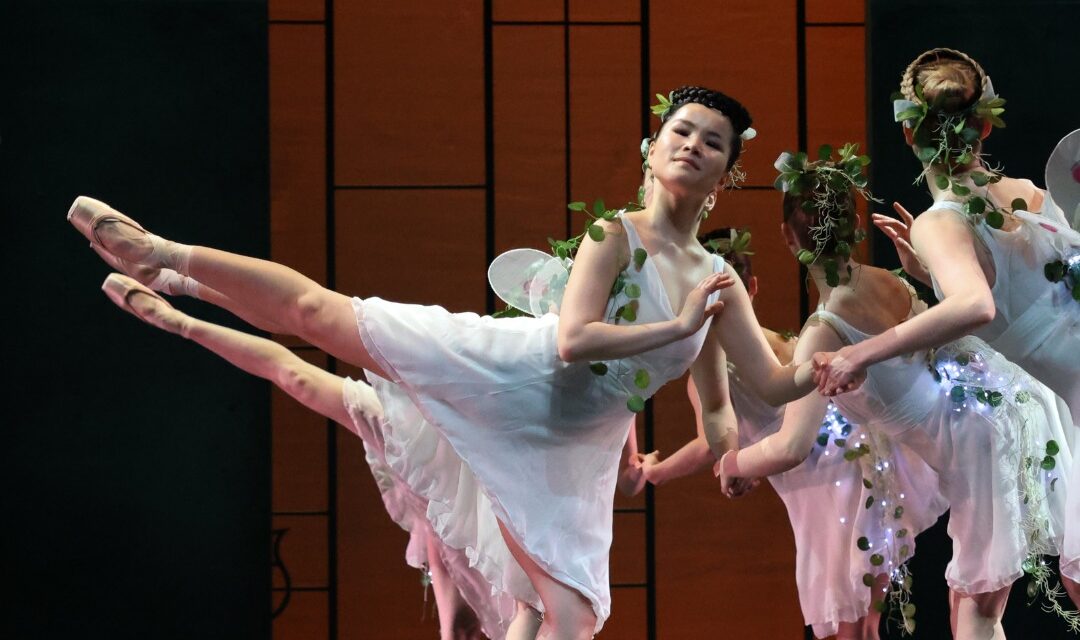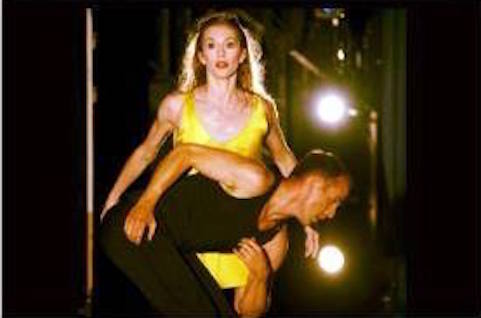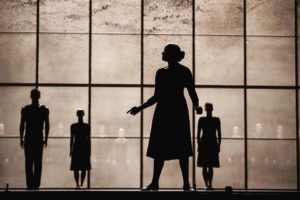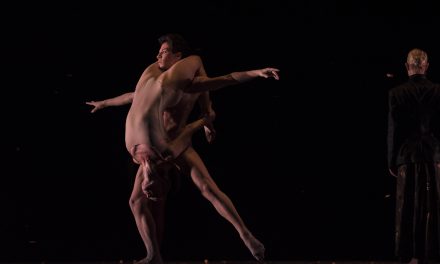Emmarose Attwood in La Sylphide. Photo: Shelby Shenkman Photography
La Sylphide with Balanchine’s Scotch Symphony
Choreography by August Bournonville & George Balanchine
Music by Hermann Lovenskjold & Felix Mendelssohn
Costumes & Set Designs by Robert Curran
A review by Amberly M. Simpson
Entire contents are copyright © 2023 by Amberly M. Simpson. All rights reserved.
Whether or not ballet is your forte, one thing is for certain: The Louisville Ballet produced a strong closer to their “Season of Transcendence” with a pairing of productions that felt both grounded and fantastical all at once.
The performance opened with Scotch Symphony, a neoclassical ballet by George Balanchine, This piece doesn’t host a traditional narrative, allowing the ensemble to work to become the main focus. Balanchine had a way of moving dancers through the space that simultaneously replicated the clean but predictable pathways that make ballet ensemble work satisfying, yet also introduced just enough new and surprising elements to keep an audience curious. The solo work, pas de deux, and pas de trois are all lovely and require a high degree of proficiency to execute, but choreographically don’t maintain the same level of compositional complexity as the ensemble work that is so eye-catching.
This was followed by the Louisville Ballet’s reimagining of August Bournonville’s version of the two-act romantic ballet La Sylphide. What really shined about this production was the design work. The choreography of La Sylphide is strong and speaks for itself (as it has for nearly 200 years) and the Louisville Ballet dancers were able to uphold this production artistically with ease. However, it was the innovative lighting design by Jesse Alford, costuming and scenic design by Robert Curran, and scenic design support by Eric Allgeier that really took this tried and true production to the next level. Each of the design elements very intentionally enhanced the choreography and story, but also had clear parallels and connections between each other. For example, the fairy lights worn by the sylphs were also paralleled in the hanging lights in the wilderness scenes. Additionally, this was also Artistic Director Robert Curran’s first time stepping into a design role on a production! One can be certain that having someone who has actually danced ballet, who is not only familiar in concept but kinesthetically with the source material, is advantageous when working to modernize a classic such as this. It’s not often in a production that you can see the strength of an artistic collaboration so clearly, but this was certainly true with this work.
The double billing of Bournonville’s La Sylphide and Balanchine’s Scotch Symphony served as a very complimentary blend. To an extent, you’re getting two different takes on the same story. Yet they are different enough from each other that this pair doesn’t feel redundant. Where the original La Sylphide is a full, evening-length narrative that ends in tragedy, Scotch Symphony feels like looking at the same story taking place in an alternate universe where the high-stakes conflict is removed and all elements of the La Sylphide – the Scottish Highlands, sylphs, etc. – can exist harmoniously together.
Additionally, I enjoyed the way this pairing played with my sense of time. La Sylphide is one of the oldest surviving romantic ballets. While we are viewing a story, choreography, and music that, as much as possible, exactly replicates Bournonville’s version produced in 1836, the lighting, scenic, and costume design all bring in elements that are distinctly modern. The result is delightfully anachronistic. Conversely, though Scotch Symphony originally premiered in 1952, making it more than 100 years younger than La Sylphide, the use of more traditional, Eurocentric attire, ballet pink tights, and elements of appropriation in the choreography (a dynamic that ballet has long been criticized for) made it feel more traditional than the very work it pays homage to.
As a dance nerd, I also enjoyed some of the subtle nods toward the origins of La Sylphide, such as the shortened skirts on the sylphs. It’s hard to say whether Marie Taglioni would approve or blush (the skirts we use nowadays are far shorter than her chosen length that was turning heads at the time), but the connection to her legacy is a sweet touch that also helps to highlight just how far the ballet world has evolved since her time. Not to mention that this choice simply helps to make the virtuosity of the Louisville Ballet’s dancers more visible.
The downside of pairing these two works is the sheer length of the production that resulted. La Sylphide by itself is a full, evening-length work, and Scotch Symphony is a full act on top of that. Had the production of La Sylphide stood alone, the show would have been a comfortable length, but adding a full, approximately 40-minute-long act in addition to that made for a two-and-a-half-hour viewing experience that was a bit fatiguing in spite of how beautiful and engaging the choreography was. In a world where concert dance struggles against the quick and in-the-palm-of-your-hand accessibility of TikTok and Instagram dopamine hits, two and a half hours is admittedly a big ask, though I think that also speaks to a larger cultural dynamic within our society, and is less so an inherent problem with the production. Still, it is a social dynamic we all, as creators must weigh and contend with.
Likewise, creators, especially within the ballet world need to contend with their audience’s ability to connect with the work. Now, as a recontextualized work, the Louisville Ballet’s rendition of La Sylphide is rather conservative. We see the replacement of more traditional garments with more modernized interpretations, and the incorporation of technical features, such as the light strings worn by the sylphs. But, as previously mentioned, the story, the music, the context, the choreography, and the essence of who each character is remains the same.
It is these dated stories where I think many people struggle to connect with older ballets like La Sylphide. In the time that romantic ballets such as this were created, the stories were a much more direct reflection of the experiences of upper-class and noble families (i.e. the audiences of these ballets when they first originated) combined with the mysticism and folklore that also pervaded that time and place. Times have most certainly changed, but even in the time of this ballet’s origin, people did not literally believe that an air spirit would come to them and lead them on a journey; the sylph represented an idea, a metaphor of caution.
So, what then, does a sylph represent to our modern society? If we, the audience, are all James…what, then, is our sylph? Or vice versa! Who/What is our Madge, the secret figure manipulating the strings within our own stories? These are the questions that ballet asks of us without explicitly stating so. This is where we find ourselves in the work where we might otherwise feel a sense of historic or virtuosic distance. However, is the recontextualization of design elements enough to help present-day audiences go to this questioning and connecting space? Is it enough to make these stories feel relevant within our current society that is not only highly industrialized but highly diverse?
Prior to watching the performance, I had the privilege of speaking with Robert Curran and getting his insights into the performance. He admitted that the ballet company does not yet hold the diversity that they desire, but also spoke to how they are trying to address this in everything from their programming, such as the Ballet Bound program, to their production design, such as the abandonment of Eurocentric costuming and pink tights. Paraphrasing, Curran relayed that the hope with this is to transform, from the top down, ballet classics into worlds that are capable of reflecting the diversity we want to see on the stage and in our companies. Then we can welcome more bottom-up efforts to start to produce artists of greater diversity through better support systems across one’s training journey. This is very much a long-game effort, but does it go far enough? And do we have a team of diverse voices, voices that reflect the diversity we are hoping to see on our stages, contributing to these conversations and efforts?
In the end, only time will tell, but I genuinely hope so. That said, I am curious to see what would happen if we took recontextualization to much more liberated (and liberating) spaces. Could we better support these efforts around diversity and audience experience by manipulating elements of the story itself? Is there room for gender-bending or gender reversal within roles? Is there room for changing the time, space, and context of the production? We know this can be done, and highly successfully, from examples like Matthew Bourne’s Swan Lake. It is certainly a risk, but so is every endeavor where our creativity is brought before an audience of people, each with their own backgrounds, experiences, and opinions. Risk can be mitigated with thoughtful and intentional artistry, and it is clear from this and their other productions that the Louisville Ballet has plenty of brilliant artists in their midst! Why not give it a try?
La Sylphide with Balanchine’s Scotch Symphony
April 13-15, 2023
Louisville Ballet
Brown Theatre
315 West Broadway
Louisville, Kentucky 40202
Louisvilleballet.org
Amberly M. Simpson is a Choreographer, Dancer, and Dance Educator/Advocate originally from Glendale, California. She specializes in Modern, Post-Modern, and Contemporary Dance forms, creating work that is often interdisciplinary in nature to provide commentary on social issues and the human condition. By day, she is the Dance Director and Musical Theatre Co-Director at Noe Middle School, but by night she serves as the Artistic Director of Ambo Dance Theatre. Amberly’s work has been presented at venues such as the American Dance Festival Movies by Movers, the Going Dutch Festival, the Midwest Regional Alternative Dance Festival, and Princeton Research Day where her collaboration with Dr. David Vartanyan received the Impact Award. In 2019, she was honored as one of the Hadley Creatives through the Community Foundation of Louisville, and in 2022 she worked alongside her Dance colleagues in the Jefferson County Public Schools to launch the first ever All County Dance program for the state of Kentucky.





